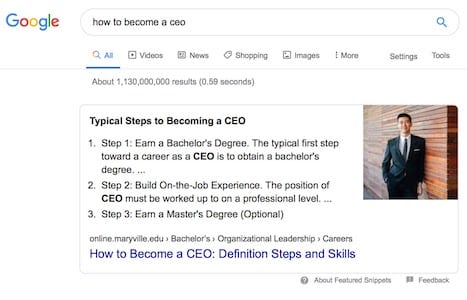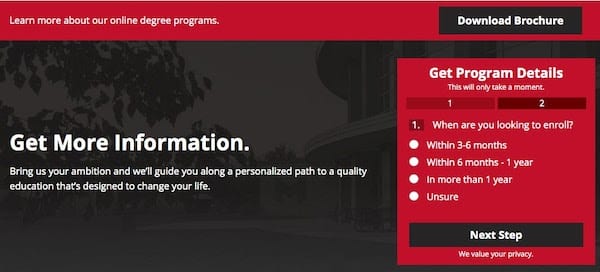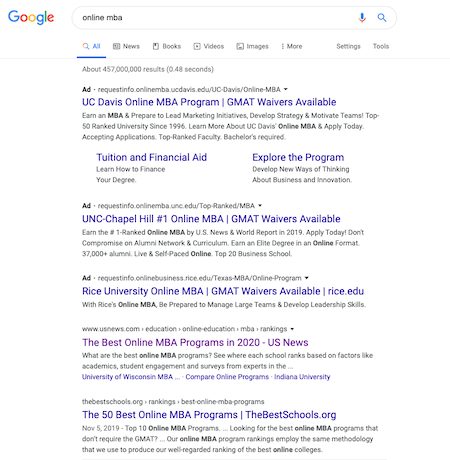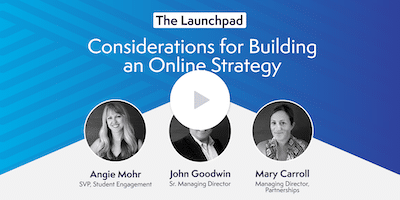6 Higher Education SEO Strategies for 2022
Boost Your Enrollment Cycle With These SEO Strategies for Higher Education
Billions of searches occur daily across global search engines through desktop, mobile, and voice search devices. These organic searches are the largest drivers of website traffic, particularly for higher education institutions, making SEO the most essential ingredient in the recipe for generating student leads. A student’s journey toward enrollment is a roller coaster of considerations. From looking at financial costs and career opportunities to assessing workload and faculty projects, students turn to search engines to answer their questions.
Optimizing your university’s website involves looking at a variety of SEO factors: webpage speed, optimized page titles and headings, URL structure, link building, content, and more. The members of Archer’s higher education SEO team are experts at every step on the path toward optimizing a university’s website, including technical on-page optimization, off-page link building, and, most importantly, content creation and promotion.
Stay relevant and bring new prospective students in with a sophisticated higher education SEO strategy.
SEO for Higher Education: What You Need to Know
While content saturation is at an all-time high and competition in higher ed remains fierce, universities must have tight SEO strategies for brand discovery.
Here are a few key insights we’ll unpack:
- Satisfying search intent is Google’s No. 1 goal.
- 65% of searches on Google do not result in a click.
- 63% of search engine visits come from mobile devices.
The audiences you’re marketing to are becoming less traditional. Capturing their attention and appearing at some point in their college enrollment journey takes value, volume, and a deep understanding of all the nuances of search engine optimization.
SEO Strategies to Boost Your College Enrollment Cycle
Our higher-ed SEO experts have pulled together a list of six strategies to help capture students along their path to college enrollment. Their expertise will help guide you in discerning what’s important in an SEO strategy and where to set focus for the rest of the year.
1. Determine Your Student Journey
Student journey maps are going to be key in helping you guide the focus and intent of your content. How are you making students aware of your programs? At what point are they considering your programs? Where in the journey do they make a decision, and what do they need to get there? Students looking to advance their academic and professional careers are at some point of the sales funnel, but they’re also at some stage in their search engine journey. If you’re doing it right, you’ve constructed this journey and provided several different routes for the different kinds of prospective students you interact with.
For example, a student might be only tangentially familiar with the construction industry, so craft a piece about construction careers graduates can launch after receiving a construction management degree. On the other hand, a student might be further down on their journey and might be at the point of more serious consideration of an engineering degree. For this student, we’ll craft a post about stress management.
If you want to get students to your website, finding blog topics is only half the game. Using keywords to optimize your content is how you push those posts to the finish line. Google’s latest algorithms emphasize value, so figure out what value you can provide your reader at every stage of inquiry.
By walking through the student’s college enrollment experience and differentiating content based on the needs of each stage, you can curate specific content to respond to their search intent, keep them engaged with your brand, and guide them down your content map to a post that encourages them to convert.
2. Satisfy Student Search Intent
Since search intent is Google’s ultimate goal, when it comes to higher education SEO, keyword research and content creation that match the student’s search intent should be a primary focus.
 The “How to Become a CEO” article above is a great example of a university-created piece of content that matches search intent and provides steps that show how the university program can help the searcher accomplish their goal. Content should discuss a range of topics that align with the university’s mission and program’s course curriculum while still keeping the searcher top of mind. With each piece of content, you’ll be able to attract a variety of students who are in different places in the student discovery process.
The “How to Become a CEO” article above is a great example of a university-created piece of content that matches search intent and provides steps that show how the university program can help the searcher accomplish their goal. Content should discuss a range of topics that align with the university’s mission and program’s course curriculum while still keeping the searcher top of mind. With each piece of content, you’ll be able to attract a variety of students who are in different places in the student discovery process.
Each of these posts should have a strong call to action (CTA) that intrigues prospective students to learn more about the university’s program and how they can become more involved and apply. This CTA could range from an aesthetically pleasing “learn more” button to a “request more information” form. Below is a screenshot of the CTA on the article mentioned above.

3. Elevate Your Content Strategy
Searchers are no longer satisfied with traditional text-based content or boring images. This is especially true for millennials and Gen Zers, who account for 42% of the U.S. population and the majority of a university’s target market. To capture the attention of these easily distracted searchers, higher education SEO strategies will need to transition from traditional articles and infographics to visually captivating and psychologically intriguing content. This refreshed content strategy should aim to not only catch a searcher’s immediate attention but also leave a lasting brand imprint to intrigue searchers to come back for more.
Check out the following example of an engaging piece of content from Zippia.com that outlines the different career paths for cost accountants. The piece is interactive, allowing the user to move their mouse along the different career paths to reveal more detailed and relevant information.
This interactive map is fun and easy to use while still providing the quality and quantity of content the user is looking for. It illustrates the kind of memorable yet useful experience required to capture a student’s attention.
4. Occupy Google Search Results
 Occupying more real estate on ever-evolving search engine results pages (SERPs) is more crucial than ever. Around 65% of all searches on Google do not result in a click. With the advent of more featured snippets, the importance of a technically sound website, structured data, and high-quality content grows.
Occupying more real estate on ever-evolving search engine results pages (SERPs) is more crucial than ever. Around 65% of all searches on Google do not result in a click. With the advent of more featured snippets, the importance of a technically sound website, structured data, and high-quality content grows.
While on-page SEO is still crucial for ranking on the SERP, off-page efforts and creating a user experience that expands past your website are the next wave of occupying internet real estate. Off-page citations like U.S. News, third-party placements, and sites like Wikipedia will push hints and signals to Google that validate your brand. Quality higher education SEO strategies should include a UX that transcends your site to stand a chance in today’s saturation.
5. Optimize Your Website for Mobile
To enhance the college enrollment funnel experience, you need to maintain the health of your website for both desktop and mobile.
Since around 63% of search engine visits come from mobile devices, it’s no question that higher education SEO teams should be focusing on the mobile user experience of their websites. Now that Google has mobile-first indexing best practices, your team has new factors to consider. If your website’s content differs between desktop and mobile, for example, then your site is at risk of having pages not indexed or crawled, which could result in a significant loss of traffic.
For starters, ensure that desktop and mobile versions of your website have identical content, as well as identical technical elements, such as structured data and meta tags. Whether you’re developing content or updating your website design, always be sure to consider both platforms in any updates you make.
6. Understand Your Competition
 With Google ads for the search term “online mba” surpassing a $70 cost per click (CPC), higher education is one of the most competitive segments of search engine rankings. Why? Simply put, graduate degree programs are expensive and have large marketing budgets. In addition, affiliate marketing is rampant in the higher education space. What’s affiliate marketing? Affiliate marketers in higher education essentially sell student leads to universities.
With Google ads for the search term “online mba” surpassing a $70 cost per click (CPC), higher education is one of the most competitive segments of search engine rankings. Why? Simply put, graduate degree programs are expensive and have large marketing budgets. In addition, affiliate marketing is rampant in the higher education space. What’s affiliate marketing? Affiliate marketers in higher education essentially sell student leads to universities.
Who are the major affiliate marketers? Red Adventures owns a number of higher-ed affiliate sites, including highereducation.com and onlinemba.com. U.S. News is also a big player in the affiliate marketing space. These affiliate sites often have large SEO budgets and benefit from degree ranking and badging tactics. Take a look at the density of non-edu sites in the search results by Googling “online mba.”
In addition to competing with a number of affiliate websites, traditional schools have to compete with for-profit institutions and institutions with powerful national and regional brands.
While it’s a competitive market, a long-term higher education SEO strategy, with a nuanced understanding of the market, can yield tremendous results around student enrollments and thought leadership.
Let Our Team Help You With Your Higher Education SEO Strategy
Archer Education’s team of SEO experts is always up to date on strategies to help your program gain visibility in prospective students’ search results. Our SEO tactics can help your university:
- Increase its visibility in student-generating keywords
- Grow the amount of organic traffic to the site
- Ensure its site is optimized for organic search
Contact us or visit our SEO tactics page to learn more about how Archer can help you reach your enrollment goals.


